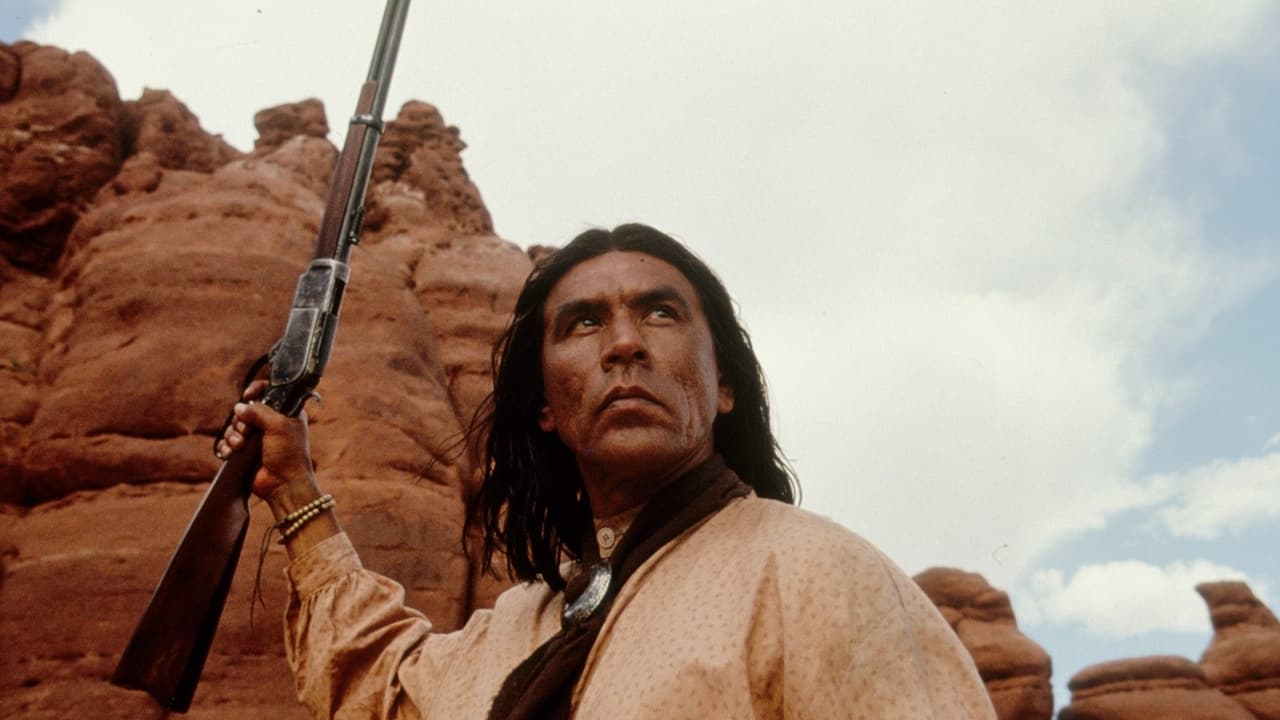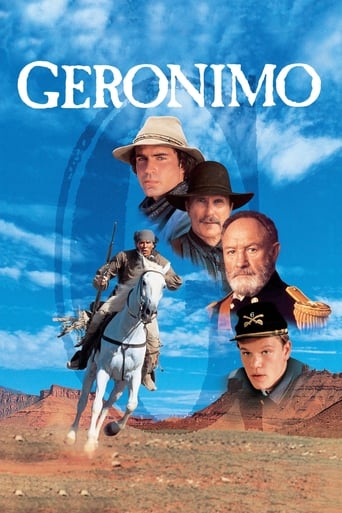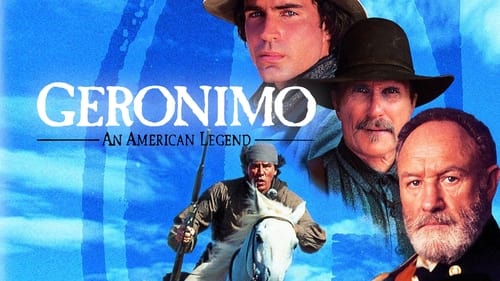



Masterful Movie
Did you people see the same film I saw?
A film with more than the usual spoiler issues. Talking about it in any detail feels akin to handing you a gift-wrapped present and saying, "I hope you like it -- It's a thriller about a diabolical secret experiment."
View MoreThis film is so real. It treats its characters with so much care and sensitivity.
View MoreI found this historical flick about the relationship between the Apache chief Geronimo (1829 - 1907) pretty interesting. I was mainly impressed by two things: the picturesque landscape that falls just short of "epic", and what I took to be reasonable or at least a convincing facsimile of historical accuracy.It isn't really a traditional Western in the sense of good guys and bad guys. Nor is it patronizing towards the Indians, as "Fort Apache" was. Like life, the universe is more complex than that, and more confusing. For the most part, General Crook (Gene Hackman) tries to compromise. His successor,General Miles (Kevin Tighe, good actor, perennial bad man), is a lying bastard.It's no wonder Geronimo (Wes Studi) is torn between trying to raise corn within the strictures of reservation life and taking off for the hills with a band of resentful warriors and their families. The Apache were pretty rough on captives too. They were artists of torture and the film doesn't shy away from it, although it doesn't get into the arrangements in any detail.Geronimo and his group wind up as prisoners of war in various place, beginning in Florida and ending at Fort Sill, Oklahoma. He was a POW for the rest of his life, but also a celebrity. He appeared at fairs, rode in Teddy Roosevelt's inaugural parade and so forth. The movie gives the impression that he spent the rest of his life behind bars.That's misleading but not entirely false. Other incidents, I would guess, are fabricated -- an encounter between a few soldiers and some bounty hunters in which the famous scout Al Sieber (Robert Duvall) is killed. He actually died when a boulder fell on him at a construction site. The honorable Lieutenant Gatewood (Jason Patric) was a real figure who admired the Apache and spoke their language but was betrayed by the Army.For what it's worth, if the US Army treated the Apache poorly, the Mexican Army did even worse.
View MoreSome say that Geronimo: An American Legend is revisionist but there is no getting away from the fact that this movie is poorly made hokum. The story begins and firmly stays with the point of view of the white man. One of the first scenes sets the tone for the following nonsense by having the American Cavalry officer played by Gene Hackman stress to his men the desire to allow the Indian women and children to escape to safety before they ride in to capture the renegade Indians.This cynical attempt at stressing the concern or at least the benevolence of the American Cavalry is ridiculous considering the well documented indiscriminate slaughter of Indian women and children perpetrated by American forces in the west.This travesty continues with Charles B. Gatewood played with angelic wetness by Jason Patric espousing an extraordinary and relentless knowledge of Apache customs, beliefs and spirituality to the young impressionable Lt. Britton Davis (Matt Damon). Ignorance and a want to stay ignorant of the Indian and their beliefs was standard for US soldiers and civilians alike at the time.The image of the Red Indian as created by Hollywood is perpetuated in this production without any attempt to shed new light on the subject. The revisionist Hollywood cliché is that the American Forces accidentally start the carnage and slaughter because of some simple misunderstanding. That the brutality is somehow impelled because of some small yet legitimate action by the Indian. Flying in the face of documented history, the general impression created by Hollywood is that the wholesale murder of the Red Indian was all a terrible mistake.The fact that Geronimo was never made a Chief because he was too impetuous and irresponsible is not broached. He is seen talking as if a Chief with retrained wisdom and thought. Many of Geromimo's own tribe found him to be dangerous and unreliable. Some still to this day wonder why Geronimo has become such an icon for white America. On a technical level this production is shot like a TV movie and the editing is especially bad. The dialogue is atrocious and unoriginal, an example being when Geronimo shoots a jug out of the hand of a Marshall at distance "That was a good shot!"......."No, I was aiming for his head!"
View MoreI write about the Apache in the Desert Exposure newspaper, and I hike Apacheria in New Mexico. While there are many other Native American groups in both AZ and NM, the Jicarilla, Mescalero, and Eastern Chiricahua are the dominant of the Apacheans. This a film represented a tremendous opportunity, with such a fine actor as Wes Studi, to allow the story to be told through Geronimo's eyes. It missed that chance. Studi gives an excellent performance as Geronimo. He certainly best resembles Geronimo among Native actors that I can think of. Geronimo was likely a sociopath. He killed remorselessly. He was a gas bag,impressed with himself. He was, the most vigilant of all the Apache. Within New Mexico, just west of the Rio Grande, and east of the Arizona line, we had: Chihuahua; Geronimo; Loco; Lozen (the woman warrior); Mangas Coloradas; Nana; Victorio; Ulzana (Jolsany). The country around Moab isn't New Mexico. Moab represented a view of the West Hollywood wanted to perpetuate. Also,Moab had amenities that no southern New Mexican towns would have offered. Silver City, where I am, has hosted most recently, "North Country." There is plenty of desert, but also, high mountains, to given the most realistic view of where Geronimo was from & where he fought, since he was born & raised in the Gila Wilderness, north of Silver City.He mostly fought the latter years in the Chiricahuas, & in Chihuahua and Sonora, Mexico. Studi would have given Geronimo the understanding the man had with having lost his entire family to the Mexicans & the intense hatred he had for them from then on. Geronimo isn't universally loved on the Mescalero & Ft. Sill Reservations, because many Chiricahua Apachewanted to give up the struggle before he did.Gene Hackman plays a superb Gen. Crook, as a no-nonsense general. He'd chased many less truculent Apaches, and put them on reservations. He was a born cavalryman, was unassuming, & was the first to understand that only Apache could find other Apache. Until then, and afterwards, when Gen. Nelson Miles took command of the campaign against Geronimo, failed to find him, and resorted to using Lt. Charles Gatewood and two principle Apaches (Martine and Kayetah), did he find Geronimo.Gatewood was a very decent man. He was respected by the Apache, since he'd been on reservation with them, & also, been in the Victorio Campaigns, among others. He was so trusted by them that Geronimo asked him, @ Canyon Embudos, in Chihuahua, in March, 1886, "What would you do?"("Would you surrender?"). Gatewood told them he would.Britton (Braa ton) Davis (played by Matt Damon), by the 1885-1886 period, was no longer centrally involved in the final chase. He was at Ft. Apache when Geronimo left. Al Sieber, played by Robert Duval, was so drunk that when Britton Davis received word that the Apaches were making "tizwin" (tiz ween), acquivalent to 3.2 beer, and asked for advice, Sieber told him to not worry about it.Geronimo and Sieber both were negatively affected by alcohol. Geronimo, died on a drunk, in 1909, @ Ft. Sill, OK. He made many bad choices because of booze. Sieber may have made more than his share, too. As far as the characters they played, I think Studi, Hackman, the guy who plays Nelson Miles, Damon, Patric, and Duvall are all solid. Patric is weakest as Gatewood. Gatewood was tall, thin,stoic, and taciturn. He was very down to earth, and for some reason, the affected southern drawl displayed by Patric seemed too affected.Gatewood, Martine and Kayitah were the ones who went in to find Geronimo. They were the last to surrender because as a group, they were hypervigilent and the toughest the Apache had.Walking and Hiking Apacheria, in temperatures up to 106º just this week, I can attest to the incredible physical prowess the Apache had. I hike with lots of gear, often alone. They lived, rode and walked with a minimum amount of gear, and were confidently self-reliant in this country. To think of even running (as they did) 75 miles, or break it down, to deduct for exaggeration, 25 miles, in that heat, in this country, where one small cañon can be incredibly rugged, steep, full of cacti, severe heights, cliffs, all kinds of problems with rattlesnakes, scorpions, tarantulas, spiders, no water to speak of ... to even go 25 miles is incredible to grasp, once you try it.They were the Spartans of Native Americans.Having been many places where they were, I can say: I love NM enough to understand why they didn't want to leave. To roam alone in this country is an awesome experience. If someone had given Wes Studi some opportunity to display even a few minutes of that aloneness in a vast emptiness, they might have gotten a great performance.This is revisionist history, for sure.But, the film's worth watching more than once.I've become far too involved with the details, now, to tolerate the entire film being shot in Utah. It's too bad Millius, Hill, etc., didn't allow the narrative to be from Geronimo's point of view, rather than Davis'. Put a protractor point on Silver City, NM, scale the device to measure out 150 miles, & draw a circle, you'll see the country where the last couple of years of the Geronimo Wars were fought. Fly over it at 1000 feet, you can grasp how rugged the country is, and how it was such a part of the entire "Legend," of Geronimo.
View MoreThe saga of the great Apache warrior Geronimo has played a great part in the history of the white man's settling at the American West, though it is a history that for many decades and centuries has been deified beyond all reason at the expense of truth. The U.S. Army's attempts at "pacifying" the Apache onto reservations along the US/Mexico border in Arizona during the 1880s led Geronimo on a campaign of getting revenge, a campaign that ended with his permanent surrender and consignment to what the Army hoped would be historical obscurity on September 4, 1886. Over the years, the saga has been told both in history books and, inevitably, in movies, with a 1962 version (featuring a rather miscast Chuck Connors as the great Apache warrior) being perhaps the most prominent. But perhaps the finest retelling could be found through the mind of director Walter Hill (The Long Riders) in his 1993 film GERONIMO: AN American LEGEND.In decades past, particularly if his opponent had been portrayed by someone like John Wayne, Geronimo would have been seen on screen as a thoroughly villainous figure. But real life rarely ever squared with the Duke's view of the Native American; and it is that fact that Hill and screenwriters John Milius and Larry Gross go after. Jason Patric (as Lt. Charles Gatewood) and Matt Damon (as 2nd Lt. Britton Davis) are the U.S. Cavalry officers assigned to bring Geronimo in for surrender upon orders of General George Crook (Gene Hackman), and with help from the expert scout Al Sieber (Robert Duvall). But when the cavalry break up a medicine man ritual on the Apache reservation at Turkey Creek, Geronimo (superbly played by Wes Studi) goes on the warpath. The film concerns itself with the dichotomy that the U.S. Army faced when dealing with the Apache in Arizona during the 1880s. On the one hand, they were the only true protection the Apache had against incoming white settlers who wanted to remove all traces of Native American life from the West; on the other hand, the Army was also being used as a tool by those same settlers. Such a bind is broken when Hackman's place is taken over by General Nelson A. Miles (Kevin Tighe), his much more hard-nosed, by-the-book successor who, as Patric learns in a hurry, has no intention of honoring any of the agreements for Apache surrender that the Army has made.Given both the cinematic reputations of Hill and Milius, both of whom are of the hardened Peckinpah school of Western demythologizing and violence, GERONIMO: AN American LEGEND could very easily have been just as violent as, say, other pro-Indian films like ULZANA'S RAID or SOLDIER BLUE. With a PG-13 rating, of course, such is not the case. But neither Hill, Milius, nor co-screenwriter Larry Gross shy too far from the historical record that shows the Army/Apache battles were very costly on both sides. And indeed, like history, the film itself is ambiguous, with that ambiguity represented in Patric's Lt. Gatewood, who knows Studi well and questions the Army's willingness to adhere to agreements it signed, which earns something of a questioning from Duvall's scout in this exchange:SIEBER: I just think you're a real sad case. You don't love who you're fightin' for, and you don't hate who you're fightin' against.GATEWOOD: Perhaps I could learn to hate with the proper vigor from you, Al.Soon, even Duvall's hardened scout comes to see that the White Man's conflict with the Apache is written not in black and white, but in shades of gray, and sometimes in red blood. And as the film shows us, America's Manifest Destiny, regardless of what John Wayne may have led generations of Americans to believe, isn't something we can boast about any longer.Hackman and Duvall, not surprisingly, show themselves for the seasoned pros they are; they give their characters the proper vigor. Patric and Damon, who were all but totally unknown at the time, also show their mettle. However, it is Studi who gives the film's greatest performance as the legendary Apache warrior; he is shown as a man of honor who fights only because he has been pushed. Such was true for all Indian tribes throughout America's westward migration. The period score by roots rock musician Ry Cooder also does a lot to add to the atmosphere of the film.In the end, GERONIMO: AN American LEGEND is a probing look at a distorted part of American history that needs to be set straight, and a critique of wrongs against a whole race that have still yet to be righted. We still haven't come to terms with our mistreatment of the Indian (or for that matter, anyone who doesn't adhere to "American" standards), but there are ways for such errors to be corrected. Good film-making has proved to be a catalyst for this; and in that regard and many others, GERONIMO: AN American LEGEND is great film-making.
View More